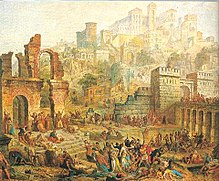
Back Judenverfolgungen zur Zeit des Ersten Kreuzzugs ALS مذابح راينلاند Arabic مدابح اليهود فى الراين ARZ Persecución de los xudíos mientres la Primer Cruzada AST Alman səlib yürüşü Azerbaijani Германски кръстоносен поход Bulgarian জার্মান ক্রুসেড, ১০৯৬ Bengali/Bangla Judenverfolgungen zur Zeit des Ersten Kreuzzugs German Γερμανική Σταυροφορία, 1096 Greek Masakroj ĉe Rejnlando Esperanto
| Rhineland massacres | |
|---|---|
| Part of the First Crusade | |
 | |
| Location | Speyer, Worms, Metz |
| Date | 1096 4856 (by the Hebrew calendar) |
| Target | French and German Jews |
| Victims | 2,000 Jews |
| Perpetrators | People's Crusade |
| Motive | Antisemitism |
The Rhineland massacres, also known as the German Crusade of 1096[1] or Gzerot Tatnó[2] (Hebrew: גזרות תתנ"ו, "Edicts of 4856"), were a series of mass murders of Jews perpetrated by mobs of French and German Christians of the People's Crusade in the year 1096, or 4856 according to the Hebrew calendar. These massacres are often seen as the first in a sequence of antisemitic events in Europe which culminated in the Holocaust.[3]
Prominent leaders of crusaders involved in the massacres included Peter the Hermit and especially Count Emicho.[4] As part of this persecution, the destruction of Jewish communities in Speyer, Worms and Mainz was noted as the Hurban Shum (Destruction of Shum).[5] These were new persecutions of the Jews in which peasant crusaders from France and Germany attacked Jewish communities. A number of historians have referred to the violence as "pogroms".[6]
- ^ Gilbert, M. (2010). The Routledge Atlas of Jewish History. Routledge. ISBN 978-0415558105. Retrieved 2014-10-05.
- ^ David Nirenberg, 'The Rhineland Massacres of Jews in the First Crusade, Memories Medieval and Modern', in Medieval Concepts of the Past: Ritual, Memory, Historiography, pp. 279–310
- ^ David Nirenberg (2002). Gerd Althoff (ed.). Medieval Concepts of the Past: Ritual, Memory, Historiography. Johannes Fried. Cambridge University Press. pp. 279–. ISBN 978-0-521-78066-7.
- ^ Chazan, Robert (1996). European Jewry and the First Crusade. U. of California Press. pp. 55–60, 127. ISBN 978-0520917767.
- ^ Shum Hebrew: שו"ם were the letters of the three towns as pronounced at the time in old French: Shaperra, Wermieza and Magenzza.
- ^ Sources describing these attacks as pogroms include:
- Richard S. Levy. Antisemitism: A Historical Encyclopedia Of Prejudice And Persecution, ABC-CLIO, 2005, ISBN 978-1851094394, p. 153.
- Christopher Tyerman. God's War: A New History of the Crusades, Harvard University Press, 2006, ISBN 978-0674023871, p. 100.
- Israel Jacob Yuval. Two Nations in Your Womb: Perceptions of Jews and Christians in Late Antiquity and the Middle Ages, University of California Press, 2008, ISBN 978-0520258181, p. 186.
- Nikolas Jaspert. The Crusades, Taylor & Francis, 2006, ISBN 978-0415359672, p. 39.
- Louis Arthur Berman. The Akedah: The Binding of Isaac, Jason Aronson, 1997, ISBN 978-1568218991, p. 92.
- Anna Sapir Abulafia, "Crusades", in Edward Kessler, Neil Wenborn. A Dictionary of Jewish-Christian Relations, Cambridge University Press, 2005, ISBN 978-0521826921, p. 116.
- Ian Davies. Teaching the Holocaust: Educational Dimensions, Principles and Practice, Continuum International Publishing Group, 2000, ISBN 978-0826448514, p. 17.
- Avner Falk. A Psychoanalytic History of the Jews, Fairleigh Dickinson University Press, 1996, ISBN 978-0838636602, p. 410.
- Hugo Slim. Killing Civilians: Method, Madness, and Morality in War, Columbia University Press, 2010, ISBN 978-0231700375, p. 47.
- Richard A. Fletcher. The Barbarian Conversion: From Paganism to Christianity, University of California Press, 1999, ISBN 978-0520218598, p. 318.
- David Biale. Power & Powerlessness in Jewish History. Random House, 2010, ISBN 978-0307772534, p. 65.
- I. S. Robinson. Henry IV of Germany 1056–1106, Cambridge University Press, 2003, ISBN 978-0521545907, p. 318.
- Will Durant. The Age of Faith. The Story of Civilization Vol. 4, Simon & Schuster, 1950, p. 391.
© MMXXIII Rich X Search. We shall prevail. All rights reserved. Rich X Search